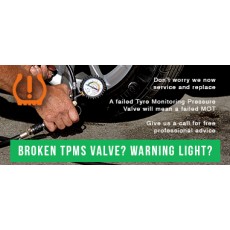
What is TPMS?
TPMS stands for Tyre Pressure Monitoring System. It’s a system that measures the pressure in the tyre and relays information to your dashboard. Some more sophisticated systems can also send the tyre temperature but we’re not so interested in that.
Direct TPMS vs Indirect TPMS
There are two types of system. Indirect TPMS is the poor relative. There has been a spate of manufacturers using this system. It’s not as accurate nor as informative. An indirect system calculates the pressure rather than measuring it. Calculations are based on wheel rotation using ABS and other sensors. An indirect system will tell you have low pressure on a specific wheel or one of your wheels. Indirect systems are rapidly being replaced by direct systems on new vehicles.
Direct TPMS is more what we are interested in. Direct TPMS uses a sensor fitted on the wheel inside the tyre and takes a direct and accurate pressure measurement. This is relayed to your dashboard as either a pressure reading, or simply inform you that a specific tyre has low pressure.
What does it mean for you?
Regularly check your tyre pressures and set them to the manufacturers spec and calibrate your system to let it know your pressures are correct. This system will use this as a reference point from that point on.
Watch your dashboard indicator. A low pressure warning or an abnormal pressure will be clearly indicated to you. You need to take action by inspecting your tyre and inflating to the required pressure or call a tyre fitting company such a Easy Tyre for advice and assistance.
What can go wrong?
Only a few things really. The sensor in the wheel is the critical part. The valve stem where you fill air can be brittle so be careful when inflating your tyres. If it does break you will get rapid deflation and since the valve core will pop out the tyre will no longer hold air. Call Easy Tyre for assistance.
The sensor could fail or the battery that powers the sensor could expire – they have a four or five year life. If this is the case you will get a TPMS fault light on your dashboard. Usually it will flash when you turn the ignition on and remain flashing. Call Easy Tyre for assistance.
What’s the law?
As of 1st November 2012, all new-type vehicles will be required by EU law to have a pressure based tyre pressure monitoring system installed. This applies to the road wheels, not the spare. As such these vehicles will require a working TPMS at the point of first MoT and onwards.
By November 2014, all new passenger vehicles will have to have TPMS installed by the manufacturer. The law is not currently retrospective, and does not apply to older vehicles. This law applies to passenger vehicles only, with no more than 7 seats
Most importantly, TPMS is now part of the annual vehicle test (MoT), and applies to all newly registered cars from January 1st 2012. This means that a car with a faulty TPMS will fail the vehicle test from January 2015. Until 2015, a faulty TPMS will only be an advisory and be listed on the testing certificate.
In summary, check your pressures regularly. Calibrate the system – follow the manual or on screen instructions. It’s designed not to be complicated. Watch for warning lights – either low pressure or faulty TPMS and call us if you need assistance.
We offer a system calibration service if it’s something you’re comfortable doing. And we also offer a TPMS sensor replacement service for faulty, broken and dead battery TPMS Sensors. Contact us today to find out more about our TPMS service



